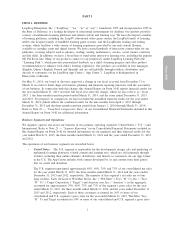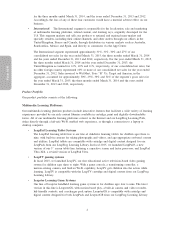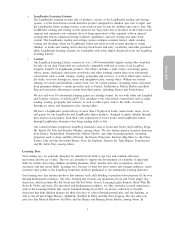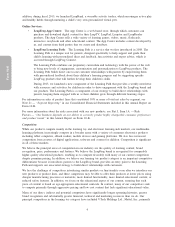LeapFrog 2015 Annual Report Download - page 18
Download and view the complete annual report
Please find page 18 of the 2015 LeapFrog annual report below. You can navigate through the pages in the report by either clicking on the pages listed below, or by using the keyword search tool below to find specific information within the annual report.
excess of the levels demanded by our customers, we could be required to record inventory write-downs for
excess and obsolete inventory, which would adversely affect our operating results. In addition, if our processes
result in our inventory levels being too low to meet customer demand, or if we fail to meet tight shipping
deadlines, we may lose sales or increase our shipping costs, which would adversely affect our operating
results.
We rely on a small group of retailers that together accounted for the majority of our annual gross sales
such that economic or other difficulties that affect these retailers or changes in their purchasing or
related decisions could have a significant impact on our business and operating results.
Our top four retailers in the year ended March 31, 2015 were Wal-Mart, Toys ‘‘R’’ Us, Target and Amazon,
which, in the aggregate, accounted for approximately 70%, 60%, 73% and 73% of the U.S. segment’s gross
sales for the year ended March 31, 2015, the three months ended March 31, 2014, and the years ended
December 31, 2013 and 2012, respectively. These top four retailers, in the aggregate, accounted for
approximately 30%, 25%, 36% and 34% of the international segment’s gross sales for the year ended
March 31, 2015, the three months ended March 31, 2014, and the years ended December 31, 2013 and 2012,
respectively. In addition, these top four retailers, in the aggregate, accounted for approximately 56%, 47%,
61% and 61% of our consolidated gross sales for the year ended March 31, 2015, the three months March 31,
2014 and the years ended December 31, 2013 and 2012, respectively. For the foreseeable future, we expect to
continue to rely on a small number of large retailers for the majority of our sales domestically and abroad.
We do not have long-term agreements with any of our retailers and retailers make all purchases by delivering
one-time purchase orders. As a result, pricing, shelf space, cooperative advertising or special promotions,
among other things, with each retailer are subject to periodic negotiation and alteration. In addition, Wal-Mart
and Target have from time to time reduced the shelf space allocated to the electronic learning aids aisle within
the toy department, which is where our multimedia platforms are merchandized and which may negatively
impact our sales at these retailers.
In addition, we rely on our retail customers to successfully sell our products to consumers. Economic and
other factors that adversely affect retailers, such as increased competition from online retailers, store closures,
consolidation in the retail sector, bankruptcies and liquidity problems may adversely affect us. For example,
the bankruptcy of Target Canada in 2014 resulted in bad debt expense of approximately $0.4 million. If any of
these retailers reduce their purchases from us, reduce our shelf space at retail, materially change the terms on
which we conduct business with them or experience a downturn in their business for any reason, our business
and operating results could be adversely affected.
If global economic conditions deteriorate, our business and financial results could be affected.
We develop and distribute educational entertainment for children. Our performance can be materially impacted
by the overall level of discretionary consumer spending. Consumers’ discretionary purchases of educational
entertainment items for children may be impacted by unemployment, foreclosures, bankruptcies, reduced
access to credit, interest rates, stagnant or declining wages, and other macroeconomic factors that affect
consumer spending behavior. The current economic recovery in the U.S. may not be sustainable or may not be
sufficiently broad-based to increase the spending throughout our consumer base. In addition, uncertainty with
respect to national debt levels in the member states of the European Union, such as Greece, may pose a
significant threat to the global economy as a whole. If these or other matters led to a deterioration of global
economic conditions, it could potentially have a material adverse effect on our business and operating results.
If our marketing and advertising efforts fail to resonate with our customers, our business and operating
results could be adversely affected.
Our products are marketed through a diverse spectrum of advertising and promotional programs. Our ability to
sell our products and services is dependent in part upon the success of these programs. Additionally, given the
importance of sales during the year-end holiday season, our marketing efforts tend to be concentrated in the
quarter ending December 31. With this concentration, it can be more difficult to accurately assess the
effectiveness of the advertising and make any necessary adjustments before the end of the December quarter.
If the marketing for our products and services fails to resonate with consumers, particularly during the critical
11
























